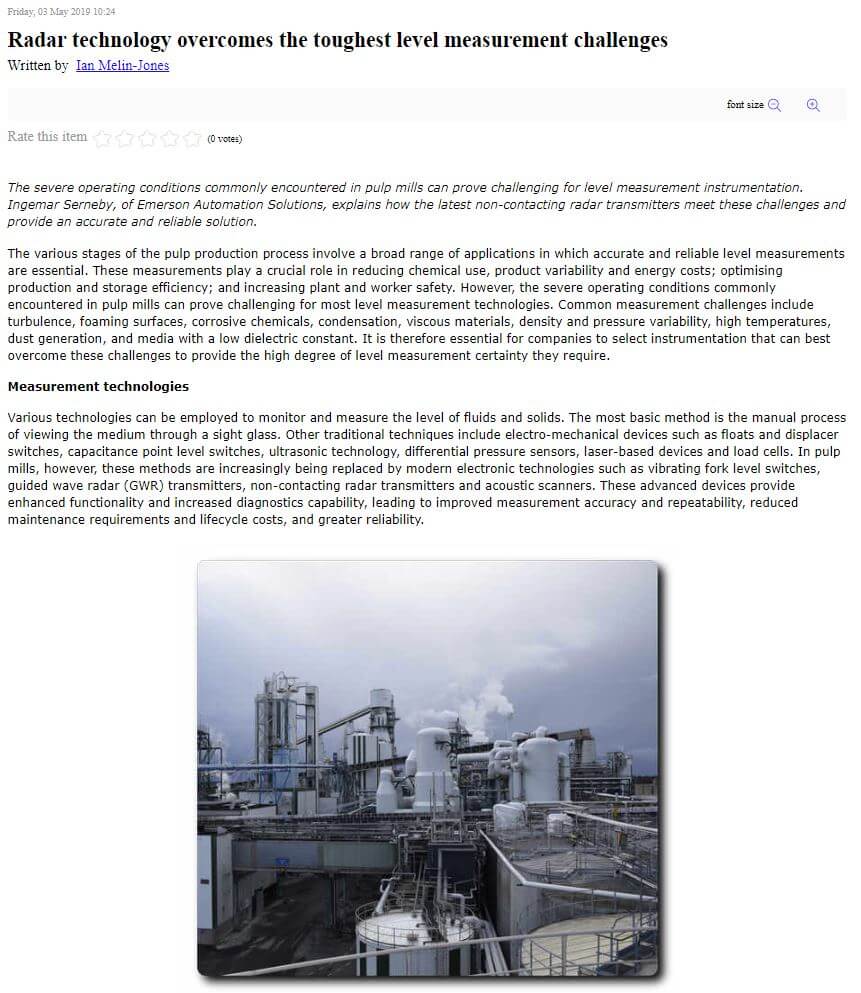A pulp mill:
…converts wood chips or other plant fibre source into a thick fibre board which can be shipped to a paper mill for further processing.
 Level measurements can be challenging in pulp manufacturing process.
Level measurements can be challenging in pulp manufacturing process.
In a Pulp-paperworld article, Radar Technology Overcomes the Toughest Level Measurement Challenges, Emerson’s Ingemar Serneby shares his expertise on how non-contacting radar level measurement technology can address these challenges.
These challenges include:
…turbulence, foaming surfaces, corrosive chemicals, condensation, viscous materials, density and pressure variability, high temperatures, dust generation, and media with a low dielectric constant.
Many level measurement options exist from manually checking levels through sight glasses to:
…electro-mechanical devices such as floats and displacer switches, capacitance point level switches, ultrasonic technology, differential pressure sensors, laser-based devices and load cells.
More modern level measurement devices are replacing these and include:
…vibrating fork level switches, guided wave radar (GWR) transmitters, non-contacting radar transmitters and acoustic scanners.
Benefits of these new technologies include:
…enhanced functionality and increased diagnostics capability, leading to improved measurement accuracy and repeatability, reduced maintenance requirements and lifecycle costs, and greater reliability.
Non-contacting radar technology addresses the challenging level measurements well. It:
…provides a top-down, direct measurement of the distance to the surface, which is highly accurate and reliable and can be used with liquids, sludges, slurries and some solids. With built-in diagnostics, a lack of moving parts, and straightforward installation and commissioning, non-contact radar transmitters provide both ease-of-use and low maintenance requirements.
The article highlights the technologies behind non-contacting radar—pulse modulated continuous wave (PMCW) and frequency modulated continuous wave (FMCW). FMCW have much greater sensitivity and accuracy but requires more power and additional wiring for this power. Ingemar highlights recent efficiency advances in the Rosemount 5408 non-contacting radar transmitter.
However, the improved energy efficiency of the latest FMCW devices allows power and communication to be provided by two wires, which eliminates the need for extra infrastructure, enables quick installation and reduces costs.
Read the article as it shares how non-contacting radar technology addresses turbulence and foaming, corrosive media and condensation, coating/viscosity/dirty antennas, density/temperature/pressure, solids measurement, dust generation, and dielectric constants. A case study is also shared about the application of these level transmitters at and pulp mill in Sweden.
Visit the Non-Contacting Radar section on Emerson.com for more on the application of this technology. You can also connect and interact with other level measurement experts in the Measurement Instrumentation group in the Emerson Exchange 365 community.





